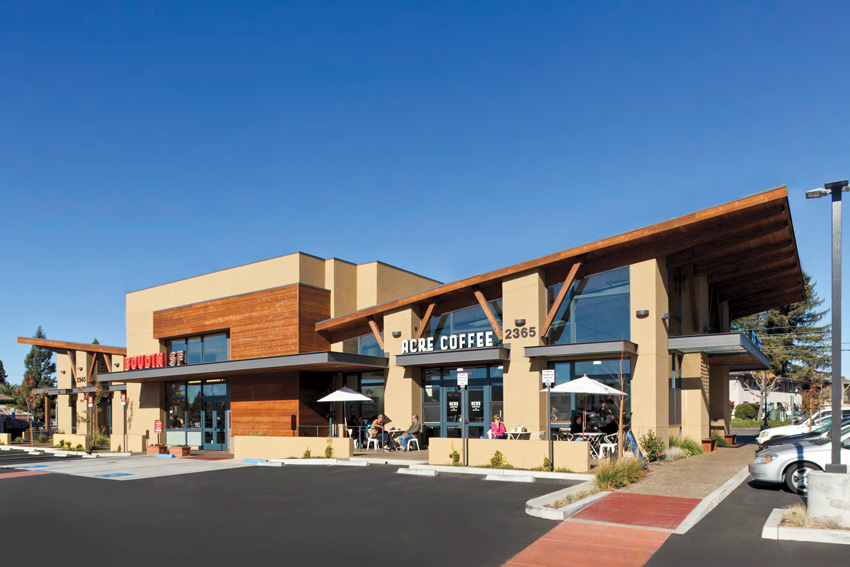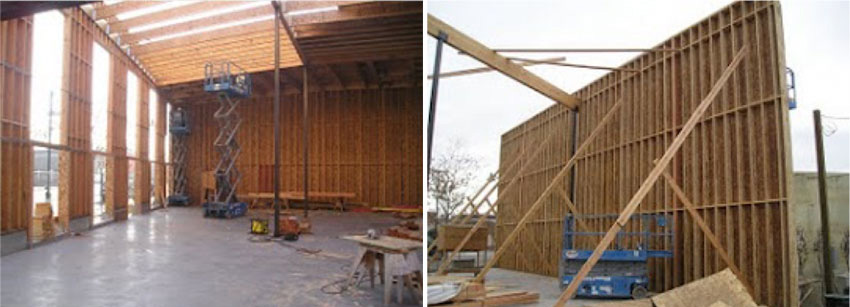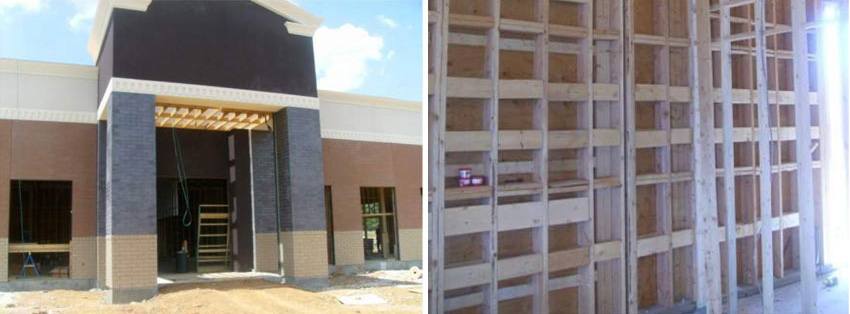Opportunities For Wood in Low-Rise Commercial Buildings
Multi-Tenant Buildings
For commercial buildings, determining allowable height and area typically includes considerations related to multiple tenants or occupancies. For example:
- Incidental uses (IBC Section 509) are those that pose greater risk of fire than the main occupancy, such as machine rooms, laundry rooms, and mechanical equipment rooms. Providing they comprise no more than 10 percent of the area of the given story and have the required fire separation, smoke separation, and/or NFPA 13-compliant automatic sprinkler systems, they are not classified as a separate occupancy for the purpose of determining allowable building height and area.
- Accessory occupancies (IBC Section 508.2) don’t pose the same level of risk as an incidental occupancy and therefore do not have the same dedicated passive or active fire safety requirements. To qualify as an accessory occupancy, the area must comprise less than 10 percent of the story area and the IBC 506 “NS” allowable limit value. For commercial buildings, no separation is required between the accessory occupancy and the main occupancy, and only the main occupancy needs to be considered when calculating height and area. Examples include storage in an office or kitchen in a community space.
- Nonseparated occupancies (IBC Section 508.3) have another level of restriction in terms of fire protection systems (IBC Chapter 9) and allowable height and area, as well as other requirements based on the most restrictive occupancy of the mix. However, the advantage is that they don’t require specified fire-rated assemblies between occupancies. An example would be the same office/storage scenario, but where the storage comprises more than 10 percent of story area. To check the allowable heights and areas of nonseparated occupancies, the nonseparated occupancies should be checked as if the entire area consists of each of the contained occupancies, with the most stringent check governing the allowable height and area of the nonseparated occupancies.
- Separated occupancies (IBC Section 508.4), as the name suggests, require fire-rated assemblies between occupancies. This separation allows for larger allowable areas than nonseparated occupancies, while allowable height is based on occupancy—i.e., the IBC allows a specific elevation or number of stories for each occupancy group. Because of this, an architect may be required to put certain occupancies on lower versus higher floors.
A good resource for height and area analysis is the 2015 Code Conforming Wood Design, a joint publication of the ICC and American Wood Council (AWC), available at www.awc.org. WoodWorks also offers a free downloadable Heights and Areas Calculator, available at www.woodworks.org, which reviews and analyzes building height and area compliance with the 2015 IBC for buildings up to six stories, with up to four occupancy groups at each level.
Fire Resistance and Detailing
Types I, II, III, and V Construction are further subdivided into two categories (IA and IB, IIA and IIB, IIIA and IIIB, and VA and VB) with the difference being the degree of fire resistance required for various building elements and assemblies. For example, in Type VA Construction, all interior and exterior load-bearing walls, floors, roofs and structural members are required to have a minimum 1-hour fire-resistance rating. In Type VB Construction, no fire-resistance rating is required.
While a detailed discussion of fire resistance is beyond the scope of this course, there are many sources for tested fire-rated assemblies. Fire-rated wood-frame assemblies can be found in publications such as:
- Underwriters Laboratories’ (UL) Fire Resistance Directory
- Intertek Testing Services’ Directory of Listed Products
- Gypsum Association’s Fire Resistance Design Manual
Wood Building Systems
Building designers interested in using wood for commercial projects have a variety of options, from exposed mass timber systems using innovative products such as cross-laminated timber (CLT), nail-laminated timber (NLT), and glued-laminated timber (glulam), to traditional dimension lumber framing that can be used to economically and effectively meet the objectives of almost any low-rise commercial project.
Wall Framing
Options for wall framing include solid sawn and finger-jointed dimension lumber, glulam framing, and structural composite lumber (SCL) products.
Ceiling height is the primary driver of wall height, and it is common for commercial spaces to have ceiling heights of 12 feet or higher. Solid sawn dimension lumber, ranging in size from 2-by-4 to 2-by-12, is commonly used for interior and exterior walls. For posts under concentrated load locations, 4-by and 6-by solid sawn lumber may be available depending on the region. Designers can also use multiple 2-by members nailed together to create larger composite members.
Again depending on the region, structural framing lumber is available in four main species groups: southern pine, Douglas-fir-larch, hem-fir, and spruce-pine-fir. Lumber in each of these groups can be made from a range of species as defined by the grading rules. Visually graded lumber is the most commonly used, with grades that include select structural, #1, #2, stud grade, etc. In some areas, machine-graded lumber may also be available, including machine stress rated (MSR) and mechanical evaluated lumber (MEL). Because product availability varies widely, designers are advised to consult with local distributors and industry experts to determine which products are most appropriate for specific applications.
Related to dimension stud lumber is finger-jointed lumber (referred to as ‘end-jointed’ lumber in the IBC), which is comprised of shorter sections of wood glued together into longer members. Per IBC Section 2303.1.1, if approved for the building application, properly graded and stamped finger-jointed lumber can be used interchangeably with the same grade and species of solid sawn lumber. Some finger-jointed lumber is labeled as “vertical use only” or “stud use only.” This lumber is not appropriate for nonvertical uses, such as headers, beams, joists, or anywhere sustained bending or tension loads are expected. For fire-rated assemblies, finger-jointed lumber must be stamped “HRA” to indicate that a heat-resistant adhesive was used in its manufacture.
Glulam framing is manufactured using small pieces of lumber that are glued together to make significantly larger beam and column elements. Glulam beams are manufactured in a variety of sizes, with custom products greater than 4 feet deep and 100 feet long available.
SCL is made from a variety of wood fiber products smaller than dimension lumber, such as veneers, and strands. This category of products includes laminated veneer lumber (LVL), laminated strand lumber (LSL), parallel strand lumber (PSL), and oriented strand lumber (OSL). These products are often used for floor beams under heavy loads and as studs in tall walls (see section below).
Manufacturers offer some glulam and SCL products specifically sized for wall applications. They can also be used for headers, heavily loaded trimmers and jacks, and sometimes posts (though solid sawn is more frequently used for this application).
While detailed structural design is beyond the scope of this course, it is valuable to know the high-level approaches to structural code compliance in framing design—i.e., prescriptive versus engineered.
With prescriptive framing design, applications suitable for each framing approach are defined and the calculation of loads onto framing members is not utilized. Prescriptive approaches applicable to some commercial buildings can be found in IBC Chapter 23 (conventional construction), and portions of the Wood Frame Construction Manual (WFCM), a referenced standard published by AWC. In both cases, the scope of the prescriptive approach is limited to 40 pounds per square foot (psf) live load on wood floors, which limits their use to commercial occupancies on the ground floor.
With an engineered approach, the wood framing system is designed to handle code-required minimum loads as defined by the IBC and referenced standards, with loading often calculated using ASCE 7-10: Minimum Design Loads for Buildings and Other Structures, and wood framing commonly designed in accordance with AWC’s National Design Specification® (NDS®) for Wood Construction, and Special Design Provisions for Wind and Seismic (SDPWS). The WFCM also provides an engineering approach to wood framing components.
Tall Wall Design
Although defined as ‘low-rise,’ many commercial structures require ‘tall walls’—20 feet and taller—to achieve desired interior heights. Wood is both appropriate and effective in these applications.
Wood-frame tall walls offer the same benefits as other wood stud walls:
- They’re able to resist snow loads on the roof and wind loads on the wall, without requiring an additional load-bearing frame.
- When wood sheathing is added to studs, the wall is effective at resisting the lateral racking loads caused by high wind and seismic events.
- They can be easily insulated to provide excellent thermal resistance.
- They can be finished with a wide range of finishing materials.
- And they can be easily modified to adapt to changing tenant/owner needs.
For commercial structures, larger lumber sizes and engineered wood products can be used to obtain the same strength for walls that are taller and longer. Shear walls and connections can be easily designed to provide the required lateral resistance. Thermal requirements can be achieved with insulation. And, by paying attention to details and selecting appropriate finishing materials, tall stud walls can meet or exceed the more stringent fire separation requirements associated with most commercial structures.
Although the design of tall walls tends to be the purview of structural engineers, it is helpful for architects to understand two nuances that can have a significant impact on cost. For example:
- While a designer may wonder what is required to reduce the weak axis unbraced length of wall studs, the NDS Commentary says that any code-accepted wall sheathing, which includes wood structural panels and gypsum board, is valid. At the same time, it is important to have mid-height wall stud blocking to brace the stud during construction, as there will be loading before the sheathing or gypsum is installed.
- If ASCE 7 is used to calculate wind loads for components and cladding, structural components and connections that will be subject to wind from a larger area may have reduced loading requirements. This is similar to a live load reduction factor.
For a fast review of wall stud checks, the WFCM includes tables of allowable spans for different stud sizes and grades under various wind and gravity loading conditions and locations in the building.












